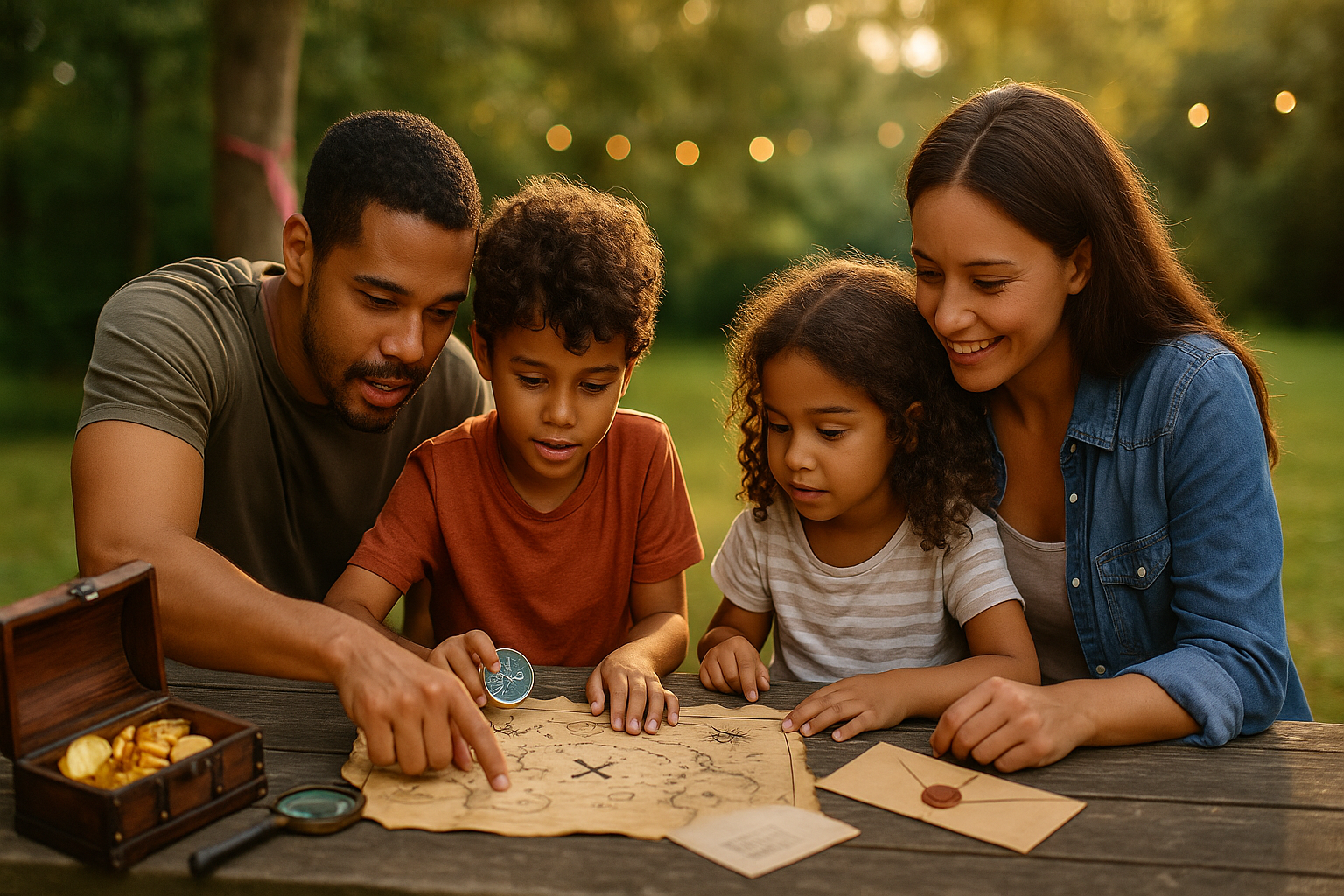Ready to turn your neighborhood or backyard into an epic adventure? This simple, repeatable plan helps you design a family treasure hunt that works for mixed ages, tight budgets, and any location. Use the framework below as your all-in-one scavenger hunt guide—from theme to clues to prizes—so your next weekend adventure ideas becomes a family classic.
Step 1: Pick a Theme & Story Hook
- Theme options: Pirates, detectives, time travelers, secret agents, nature rangers, space explorers.
- Story hook (1–2 sentences): “A famous explorer hid a chest somewhere in our neighborhood. Only true adventurers can follow the clues!”
- Artifacts: Add a stamped “expedition pass,” faux map edges (tear + tea stain), and a team name board for instant immersion.
Step 2: Choose the Playing Field & Boundaries
- Locations: Living room → backyard → front porch; or park loop with visible landmarks.
- Safety first: Set a visible boundary line, assign younger players a buddy, and keep an adult at the start/finish hub.
- Time box: 45–90 minutes total to keep energy high.
Step 3: Map Your Route (5–7 Stops)
Great hunts feel like progress. Sketch a simple route with variety—high/low, inside/outside, loud/quiet. Start easy, peak in the middle, end with a dramatic reveal.
- Stop 1 (warm-up): Instant win to build confidence.
- Stops 2–4 (core challenge): Mix puzzles and physical tasks.
- Stop 5 (boss clue): Slightly harder—requires teamwork.
- Finale: A locked box or hidden cache with the prize.
Step 4: Craft Clues with the 3C Formula
3C = Clear → Clever → Cooperative. Each clue should be understandable, a little surprising, and better with two or more brains.
- Riddle clue: “I have hands but cannot clap; I watch the day go ‘round.” (Answer: clock)
- Cipher clue: Use a simple letter shift or symbol grid taped under a table.
- Photo clue: Close-up of a backyard object—kids must match angle/texture to find it.
- Physical task: “Build a three-cup tower that stands for 10 seconds to earn the next clue.”
- Observation trail: “Count the fence posts to the old oak, then turn right.”
Tip: Put the answer location on the back in tiny print for the game master—just in case.
Step 5: Balance Difficulty for Mixed Ages
- Dual-layer clues: A picture hint for little kids + a word riddle for older ones—both point to the same place.
- Role cards: Navigator (map), Decoder (cipher wheel), Runner (fetch), Archivist (stamps the passport). Rotate roles at each stop.
- Time gates: If a clue goes over 5 minutes, the game master offers a first hint; at 8 minutes, a second hint.
Step 6: Build Props & the Final Treasure
- Clue carriers: Envelopes sealed with stickers, film canisters, plastic eggs, or tiny tins with numbers.
- Locks: Use a 3-digit combo (answers add up), or a simple ribbon knot “lock” kids must untie by completing a mini-task.
- Treasure chest: Shoebox or lunchbox lined with fabric. Fill with chocolate coins, stickers, DIY medals, or “experience coupons” (movie night pick, stay-up-late pass).
Step 7: Run-of-Show (Your Game-Day Plan)
- T-15 minutes: Hide clues in route order; test any lock or task.
- T-5 minutes: Brief safety rules + show passports/roles.
- Go time: Hand over Clue #1 and start a 60–90 minute timer.
- Halfway mark: Water break + quick team photo.
- Finale: Drum roll, treasure reveal, victory song, and group picture with the “found” chest.
Sample 60-Minute Family Treasure Hunt
- 5 min: Intro + role assignment.
- 10 min: Stops 1–2 (riddle + photo match).
- 15 min: Stops 3–4 (cipher + physical tower).
- 10 min: Stop 5 (observation trail to tree marker).
- 10 min: Finale (3-digit combo from previous answers).
- 10 min: Treasure reveal + medals + thank-yous.
Rain Plan & Accessibility
- Indoors: Hide clues in books, under chairs, inside a pot with a paper “map” taped to the lid.
- Low-impact: Swap running for rolling a ball between stations; seated cipher/spot-the-difference puzzles.
- Sensory-friendly: Keep lighting steady, avoid loud timers, and provide noise-reducing headphones if needed.
After the Hunt: Keep the Magic
- Debrief: “What was the hardest clue? The funniest moment?”
- Memory album: Paste the passports and a few clues into a notebook; add one photo and a short caption.
- Pass it on: Save props in a labeled bag so kids can host next time.
Conclusion
Memorable hunts are simple, clear, and cooperative. Pick a theme, map 5–7 stops, mix clue types, and finish with a chest everyone helps open. With this scavenger hunt guide in hand, your family treasure hunt will become a repeatable tradition and one of the easiest weekend adventure ideas to set up—no pirates required.
